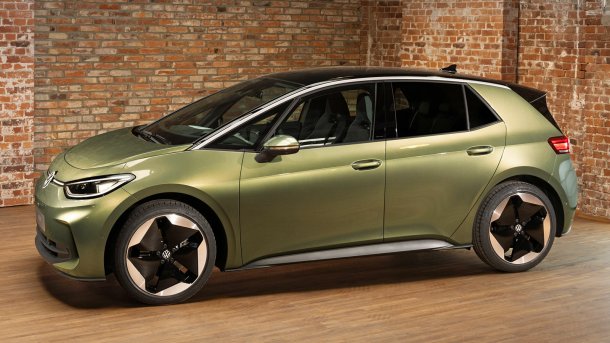VW ID.3 facelift comes with refined interiors and new software
The redesign of the VW ID.3 is intended to make the electric car appear less cheap on the inside. VW also promises progress with the software.

(Bild: VW)
- Christoph M. Schwarzer
(Hier finden Sie die deutsche Version des Beitrags)
As you can see, you don't see anything: From the outside, only connoisseurs notice the redesign of the VW ID.3. The formerly black element at the front in front of the windshield is now painted in body color, for example in the new shade Dark Olive Green. The name lettering at the rear is in white. The front and rear bumpers have been optimized, resulting in a drag coefficient of cW 0.263. Volkswagen has been asking for the price of at least 43,995 euros since December: anyone who has ordered since then will get their hands on the fresh ID.3 from the fourth quarter of this year. The real improvement, however, is in the interior. The cheap-looking interior is to be upgraded with new materials - animal-free, of course, as Volkswagen emphasizes.
Hardly any change in technical data
To begin with and for the sake of completeness, the technical data should nevertheless be mentioned: As before, there are two battery sizes with a net energy content of 58 and 77 kWh, respectively. A third, smaller traction battery has been announced. Perhaps the low-cost LFP cell chemistry with lithium iron phosphate will be used here for the first time at Volkswagen.
The charging time of the 58-kWh traction battery from five to 80 percent is 35 minutes, and 30 minutes are promised for the 77-kWh storage. The peak power at the DC pillar is 120 kW, and the large battery can be topped up with up to 170 kW charging power. The average C-rate as a comparative value for the charging speed has thus remained constant. It is important to note that, as with all manufacturers, the promised charging times can only be achieved under ideal conditions.
The electric motor in both versions produces 150 kW, which is enough for a minimum of 7.3 seconds (77 kWh: 7.9 seconds) to 100 km/h. The range according to the WLTP legal measurement procedure is 426 km (77 kWh: 546 km). The drawbar load for the rear wheel carrier is unchanged at 75 kg. Volkswagen makes no reference to a trailer load or even a roof load; it therefore remains at zero kilograms in each case.
Less plastic, more value
One of the major criticisms of the previous ID.3 was the cost-optimized choice of materials in the interior. Volkswagen has clearly made up for this. The door panels are reminiscent of the identically built Cupra Born, and the surfaces are softer. We don't know exactly what the standard base interior looks like. However, it should not be difficult to surpass the previous level.
VW ID.3 Facelift (5 Bilder)

The reality has to show how well the software revision has succeeded. The system should be more powerful and wirelessly updateable over the air (OTA). The sliders for operating the automatic climate control, for example, remain unlit; like the touch controls on the steering wheel, this will not change until 2024. The navigation system and the dual-zone instead of single-zone climate control can be activated at a later date for a fee ("Functions on Demand").
Prepared for bidirectional charging
In contrast, the e-route planner, Plug & Charge at certain fast charging stations (currently Ionity and Aral Pulse are usually integrated), and preparation for bidirectional charging are standard. The details are important here: the e-route planner automatically calculates the best charging stops if the range is too short. However, there is no mention of preconditioning the traction battery, i.e. selective heating up or cooling down for an optimal charging speed. This elementary feature is still missing.
VW ID.3 Facelift (4 Bilder)

In the case of bidirectional charging, it is likely that Volkswagen will work with an established system provider to offer a DC rather than AC solution for the home. We expect sales to start at the end of 2024. It will certainly not be inexpensive, but it could make sense from an efficiency perspective in conjunction with a photovoltaic system.
Strong concept, price too high
What customers are left with in any case is an electric car that is strong in concept. The Modular Electrification Building Block (MEB) platform with rear-wheel drive and a small turning circle (10.3 meters) is outstanding. Actually, the VW ID.3 could now have arrived where it always wanted to be. Only the price is much too high. Unfortunately, this does not distinguish the ID.3 in the slightest from competitors like the Renault Megane E-Tech (review) or the Kia Niro EV (review). Electric cars in the compact segment have to become much cheaper. Or the Chinese manufacturers will fill this gap: An MG4 electric comparable to the ID.3 costs 37,990 euros even in the highest Luxury trim.
(mfz)